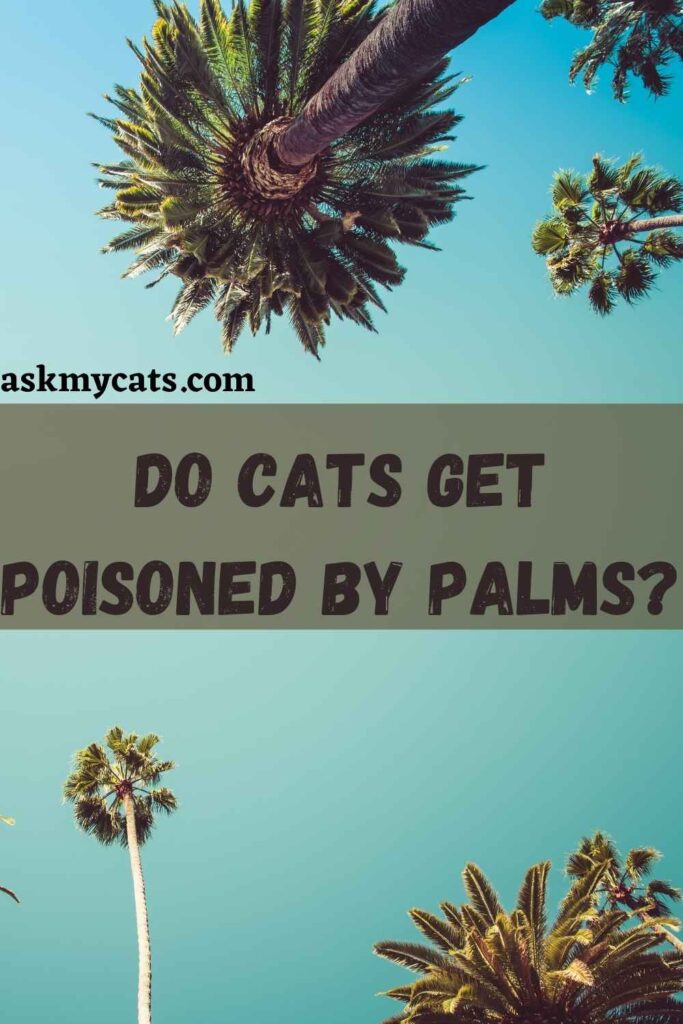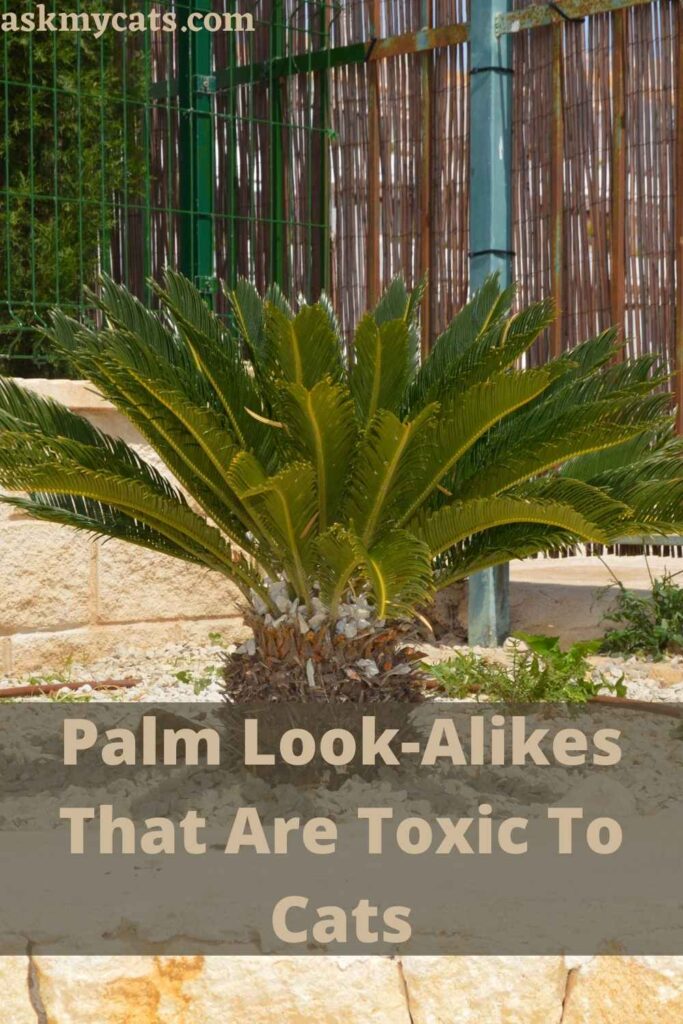Images of palm trees are associated with fantasies of being stranded on an island paradise. When you’re stuck in the snow, a healthy indoor palm can transport you thousands of miles to the sun and sandy beaches of the tropics. Interior designers liberally use the image to create a relaxed atmosphere.
So far, botanical prints have been the dominant trend of the 2020s, with palm-leaf graphics in high demand.
However, are palms toxic to cats?
No, palms are not toxic to cats. The majority of palms that are sold as houseplants are non-toxic to cats. The exception is the Sago Palm, which is actually a cycad rather than a palm.
This article will tell you more about the palms and cat’s relationship and how can you keep your cat away from them.


Give Your Cat the Perfect Day
Get the Free Ebook!
What Are Palms?
The Arecaceae is a family of perennial flowering plants in the monocot order Arecales. Their growth form can be climbers, shrubs, tree-like and stemless plants, all commonly known as palms.
Palm trees are those that have a tree-like shape. There are currently 181 genera and approximately 2,600 species known, the majority of which are restricted to tropical and subtropical climates.
Most palms are distinguished by large, compound, evergreen leaves called fronds that are arranged at the top of an unbranched stem.
Palms, on the other hand, have a wide range of physical characteristics and can be found in nearly every type of habitat, from rainforests to deserts.
Palms are one of the most well-known and widely cultivated plant families. They have played an important role in human history for a long time.
Palms are used to making a variety of everyday products and foods. Palms are now widely used in landscaping, making them one of the most economically important plants.
Palms were symbols of victory, peace, and fertility in many historical cultures due to their importance as food. Palms now represent the tropics and vacations for people who live in colder climates.
The majority of palms are native to tropical and subtropical climates. Palms thrive in moist, hot climates, but they can also be found in a variety of other habitats.
Their diversity is greatest in wet, lowland forests. South America, the Caribbean, and parts of the South Pacific and southern Asia are areas of concentration.
Colombia may have the most palm species of any country. Some palms are also native to desert areas such as the Arabian Peninsula and parts of northwestern Mexico.
Only about 130 palm species grow entirely outside of the tropics, primarily in humid lowland subtropical climates, highlands in southern Asia, and along with the Mediterranean Sea’s rim lands.
Do Cats Get Poisoned By Palms?
No, cats do not get poisoned by palms.

If you have cats, you may have noticed warnings when purchasing your first houseplant that some plants are hazardous.
Given how some cats will eat everything that is on the floor or go out of their way to chew and put items in their mouth that they shouldn’t if your plant is harmful, it shouldn’t be in the house at all.
Palm trees are one of the most popular artificial and genuine plants purchased by homeowners trying to freshen up their surroundings.
A palm tree, as a tropical plant, can give majesty and the sensation of a midsummer paradise to any setting.
However, if you have a cat, you must consider whether palm leaves are poisonous to cats.
Most palms sold commercially as houseplants are non-toxic to cats. The Sago Palm, on the other hand, is a cycad rather than a palm.
All parts of this plant are toxic to the point of death for your cat. When working with a Sago Palm, even humans must wear gloves.
Other palm-like plants, such as Dracaenas and Yuccas, contain toxic substances that are toxic to cats.
Palms come in a variety of shapes and sizes, and to be honest, they all appear very similar. The Majesty Palm, which is the most common and absolutely nontoxic to cats and dogs, is typically sold in large stores like Amazon and IKEA. “ravenea rivilaris” should be the Latin name on the tag.
The Majesty Palm thrives in medium to high light and adapts to both hot and cold weather.
Areca and Parlor Palms have a similar appearance to Majesty Palms but are a little more exquisite. Their fronds are smaller and lighter, but they still grow tall and are safe for cats to eat.
Ponytail Palms are smaller types that can grow to be quite large. They’re also rather prevalent in markets. Ponytail palms, unlike the other three, are not in the palm family, although they do look like them and are safe for cats.
Popular Garden Palms That Are Hazardous To Cats
Popular garden palms that are hazardous to cats are Pheonix and Washingtonia or Mexican Fan Palm.
Several of the larger palm species will thrive in North America’s warmer climates.
Pheonix and Washingtonia are two examples, as is the Mexican Fan Palm.
When plants are young, they develop defence mechanisms against predatory animals.
On the fronds and even the fruit, spikes and thorns of varying lengths form. The razor-sharp leaves can cause serious injury to your cat’s flesh.
Although the spiky exterior should deter any curious cat, some have been observed climbing up palms or foraging in fallen leaves despite these obvious cues.
Fungi and other harmful bacteria are invariably present in the spikes, and infection can spread through an open wound.
These palms are difficult to prune, but it is critical that they be done on a regular basis. Falling leaves are hefty and have jagged edges.
Heavy palm fruit is also a hazard. Some seeds can weigh up to 50 pounds and have caused property damage.
Caryotas or Fishtail palm fruit is smaller but toxic enough to cause skin irritation to your cat and you if handled without gloves or tramped on barefoot. They will cause abdominal pain to your cat if consumed.
Palm Look-Alikes That Are Toxic To Cats

Palm look-alikes that are toxic to cats are Sago palm, Dracaenas and yucca plants.
The Sago ‘Palm,’ also known as the Coontie or Cardboard Palm, is a cycad rather than a palm.
It has a large, untidy stem and a small number of stiff, prickly fronds that point upward.
It doesn’t flower, but it does produce fruit and seeds.
It is a slow-growing plant that can reach a height of 15 feet in the right conditions.
Although sago palms make attractive houseplants and are popular among bonsai enthusiasts, they must be kept away from curious cats and other small inhabitants of your home.
From your cats’ point of view, the trunk may be appealing as a scratching post, but the leaves are prickly and mostly stationary, so they would be unappealing. The seeds, on the other hand, are gleaming oval objects that may pique your interest.
Every part of the plant is toxic to your cat, even in its tiniest form, with the seeds being the most toxic.
They contain cyasin, a neurotoxin, and carcinogen that causes vomiting, diarrhoea, seizures, and liver failure.
The severity of the poison’s effects will be determined by the cat’s age, overall health, and the amount ingested in relation to its size.
Irritation in the digestive system can result in severe dehydration, and impaired liver function can result in permanent systemic damage over time.
Although it is not guaranteed that the poison will kill the cat, it is best to consult a veterinarian as soon as possible.
Dracaenas are well-liked houseplants. There are over a hundred different varieties, some of which look like palms.
Small cats are poisoned by the leaves.
They contain a bitter substance called saponin, which makes the leaves unpalatable. This substance is found in varying amounts in a variety of plants, including soapwort, which is used in the production of soap. It is not harmful to humans.
Saponin poisoning has similar effects to cyasin poisoning in Sago Palms.
If you suspect your cat has eaten any leaves and is exhibiting any symptoms, you should contact a veterinarian right away. The treatment is simple if caught early on.
When mature, certain yucca plants resemble palms. There are 40 yucca species, many of which are popular house and garden plants.
Unfortunately, for the same reason as Dracaenas, they are toxic to cats and dogs. Saponin, a steroidal substance, is found in the leaves.
Symptoms Of Sago Palm Poisoning?
Symptoms of sago palm poisoning are vomiting, drooling, and diarrhoea.

Sago palm is toxic to cats, according to the American Society for the Prevention of Cruelty to Animals.
The toxin cycasin is found in all parts of the plant, including the leaves.
Because the seeds contain the highest concentration of cycasin, they are the most poisonous part of the plant.
Initial symptoms in pets can appear in as little as 15 minutes and include vomiting, drooling, diarrhoea, and a loss of appetite.
Damage to the liver and central nervous system may occur within two to three days, eventually leading to death.
The sago palm is poisonous in all parts, but the seeds (nuts) are the most toxic to cats and are easier for cats to eat than the prickly fronds.
Even ingesting a small amount of the plant can have serious consequences. Several toxic compounds are found in the sago palm.
These compounds have the potential to cause severe gastrointestinal upset, affect the nervous system, or harm the liver.
Poisoning symptoms can appear as soon as 15 minutes after ingestion, but in some cases, symptoms may not appear for several hours.
Low blood glucose levels and decreased blood clotting ability can result in bleeding both externally (nose bleeds, blood in the urine or stool) and internally.
Death may occur as a result of blood loss and shock if these signs are not recognised and treated.
If you notice that your cat has consumed a sago palm, do not wait for symptoms to appear. The sooner you seek treatment, the better your pet’s chances of survival.
Contact your local veterinarian or the ASPCA Animal Poison Control Center at 888-426-4435 for assistance. You may be required to pay a consultation fee to the ASPCA.
When you bring your cat in, your veterinarian will immediately begin an aggressive decontamination and treatment process.
According to the Pet Poison Helpline, even with treatment, the survival rate is only about 50%.
Are Fake Palms Toxic To Cats?
No, fake palms are not toxic to cats.
A fake palm tree is not poisonous. Cats are not poisoned by it. If you’re worried about what a real palm tree might do and the possibility of a pet accidentally ingesting a piece of the plant, an artificial palm tree is your best bet.
Aside from toxicity, there are numerous advantages to purchasing a fake palm tree. They do not require watering.
They do not require sunlight. They also look almost identical to the real thing, at least when purchased from a premium fake plants brand.
Frequently Asked Questions
Do Cats Like Palm?
Palms are not among the plants that cats dislike or prefer. Planting palms in your home or garden will reveal this. Examine your cat to see if he or she is purring and walking around the plant. If this is the case, your cat will enjoy the palms.
If I have cats, what is a decent palm to plant indoors?
Lady Palms, which are native to the Asian Pacific, come in ten different species, all of which are good for cat-run houses. They are non-toxic and more compact than the more common palms. The ability to absorb ammonia from the air is their most important feature. To put it another way, they mask the odour of kitty litter. They might be placed near the cat litter tray to properly eliminate any unpleasant scents.
Is Sago Palm toxic to humans?
Though humans in the Western Pacific eat the processed flour from the stem pith, it is toxic if not prepared properly due to the presence of glycosides and the amino acid BMAA. Poisonous seeds and leaves are also present. Vomiting, diarrhoea, headaches, dizziness, and convulsions may occur after consuming sago palm. According to North Carolina State University, sago palm is only harmful in big numbers.
Final Words
Palms are not poisonous to cats, but the thorns may irritate your cat’s jaws and cause digestive issues. Nonetheless, with palms nearby, your cat should be safe.
If you have any questions, please leave them in the comments section.
